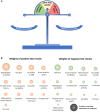Classification vs diagnostic criteria: the challenge of diagnosing axial spondyloarthritis
- PMID: 33053191
- PMCID: PMC7566535
- DOI: 10.1093/rheumatology/keaa250
Classification vs diagnostic criteria: the challenge of diagnosing axial spondyloarthritis
Abstract
In recent years, significant progress has been made in improving the early diagnosis of spondyloarthritides (SpA), including axial SpA. Nonetheless, there are still issues related to the application of classification criteria for making the primary diagnosis of SpA in the daily practice. There are substantial conceptional and operational differences between the diagnostic vs classification approach. Although it is not possible to develop true diagnostic criteria for natural reasons as discussed in this review, the main principles of the diagnostic approach can be clearly defined: consider the pre-test probability of the disease, evaluate positive and negative results of the diagnostic test, exclude other entities, and estimate the probability of the disease at the end. Classification criteria should only be applied to patients with an established diagnosis and aimed at the identification of a rather homogeneous group of patients for the conduction of clinical research.
Keywords: ankylosing spondylitis; axial spondyloarthritis; classification; diagnosis; magnetic resonance imaging.
© The Author(s) 2020. Published by Oxford University Press on behalf of the British Society for Rheumatology.
Figures




References
-
- Sieper J, Poddubnyy D. Axial spondyloarthritis. Lancet 2017;390:73–84. - PubMed
-
- van der Linden S, Valkenburg HA, Cats A. Evaluation of diagnostic criteria for ankylosing spondylitis. A proposal for modification of the New York criteria. Arthritis Rheum 1984;27:361–8. - PubMed
-
- Boel A, Molto A, van der Heijde D et al. Do patients with axial spondyloarthritis with radiographic sacroiliitis fulfil both the modified New York criteria and the ASAS axial spondyloarthritis criteria? Results from eight cohorts. Ann Rheum Dis 2019;78:1545–9. - PubMed
-
- Redeker I, Callhoff J, Hoffmann F et al. Determinants of diagnostic delay in axial spondyloarthritis: an analysis based on linked claims and patient-reported survey data. Rheumatology 2019;58:1634–8. - PubMed
Publication types
MeSH terms
LinkOut - more resources
Full Text Sources
Research Materials

